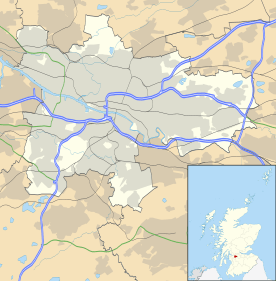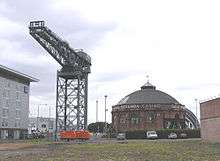Finnieston
Finnieston
| |
|---|---|
 Finnieston Finnieston shown within Glasgow | |
| Population | 8,989 (2016)[1] |
| OS grid reference | NS569656 |
| Council area | |
| Lieutenancy area |
|
| Country | Scotland |
| Sovereign state | United Kingdom |
| Post town | GLASGOW |
| Postcode district | G3 |
| Dialling code | 0141 |
| Police | Scottish |
| Fire | Scottish |
| Ambulance | Scottish |
| EU Parliament | Scotland |
| UK Parliament | |
| Scottish Parliament | |

Finnieston is an area of Glasgow, Scotland. Situated on the North bank of the River Clyde between the city's West End and the city centre. Home to the SECC and SSE Hydro, where many musical concerts, sporting events and conferences are held.[2] It is also the location of Glasgow City Heliport, home base of both the Police Scotland air support unit and the Scottish Ambulance Service "Helimed 5".[3][4]
History
The village of Finnieston was established in 1768 on the lands of Stobcross by Matthew Orr, the owner of Stobcross House. Orr named the new village "Finnieston" in honour of the Reverend John Finnie, who had been his tutor.
The area has had a significant change in land-use since deindustrialisation.[5] Previously, Finnieston was an area of warehouses and docks — the film Deathwatch (a.k.a. "La Mort en Direct"), used this aspect extensively in location shots.
Today Finnieston has been promoted and built up as a modern residential and leisure area, mirroring Shoreditch in Greater London. To this end many new bars and restaurants have been established.[6] There is modern housing, office, retail, leisure and arts & culture developments. Finnieston Street is a major junction on the Clydeside Expressway, and on 18 September 2006, was augmented with the addition of the Clyde Arc (known locally as "The Squinty Bridge") over the River Clyde.[7]
In 2016, Finnieston ranked first in The Times list '20 Hippest Places to Live in Britain' and The Herald claimed it the 'Hippest Place in Britain'[8]
Transport
Exhibition Centre railway station, on the Argyle Line, was previously known as Stobcross station. Built by the Glasgow Central Railway and opened in 1894, it was closed in 1955. When it was reopened in 1979 it was called 'Finnieston' until it was given its current name in 1986. A separate Finnieston railway station of the Glasgow City and District Railway was opened in 1886 but is now disused. However, the line is still in use as part of the North Clyde Line.
Landmarks
The Corunna Bowling Club located on A-Listed St Vincent Crescent has been a key feature of the area since 1850.[9][10]
The Clyde Arc (known locally as "The Squinty Bridge") over the River Clyde sits to the South of Finnieston.[7]
The SECC, where many musical concerts and important conferences are held.[2]
In 2013 the SSE Hydro opened next to the SECC and welcomed over 1 million visitors per year to the venue and surrounding area.[11] In 2016 the SSE Hydro boasted the title as 8th largest venue in the world.[12]
Natives
- Danny McGrain, Scottish footballer
- Sharleen Spiteri, Songwriter
References
- ↑ "statistics.gov.scot - Finnieston and Kelvinhaugh - 07". statistics.gov.scot.
- 1 2 "Glasgow wins international pathology congress". Conference News. 23 October 2014. Retrieved 31 October 2014.
- ↑ "About Us". Bond Air Services.
- ↑ "Planning submission". glasgow.gov.uk. Retrieved 2011-10-08.
- ↑ MacLeod, Gordon (2002). "From Urban Entrepreneurialism to a "Revanchist City"? On the Spatial Injustices of Glasgow's Renaissance" (PDF). Antipode. Oxford and Malden, MA: Blackwell Publishers. 34: 602–624. doi:10.1111/1467-8330.00256. Retrieved 31 October 2014.
- ↑ McKelvie, Robin (9 February 2014). "A day in Finnieston, Glasgow: city guide" – via www.theguardian.com.
- 1 2 "Date for 'Squinty Bridge' opening". BBC News. 5 June 2008. Retrieved 31 October 2014.
- ↑ "The Shoreditch effect: How Finnieston became the hippest place in Britain". HeraldScotland.
- ↑ "Campaign to save greenspace at Corunna Bowling Club agrees to explore buy-out". Glasgow West End Today. 15 January 2017.
- ↑ "Corunna Bowling Club - History". corunnabowlingclub.yolasite.com.
- ↑ "Timeline". SSE Hydro Official Website. Retrieved 12 September 2009.
- ↑ "TOP 200 ARENA VENUES 2016" (PDF). 31 December 2016.
External links